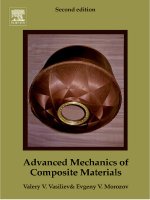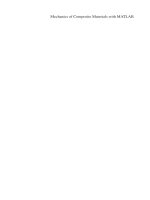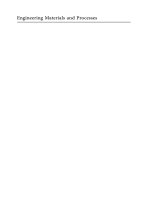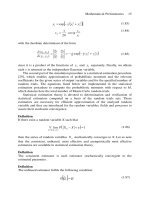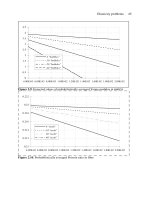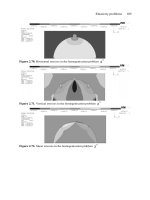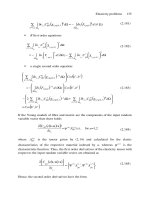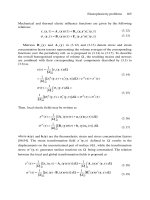ADVANCED MECHANICS OF COMPOSITE MATERIALS Episode 15 doc
Bạn đang xem bản rút gọn của tài liệu. Xem và tải ngay bản đầy đủ của tài liệu tại đây (863.4 KB, 15 trang )
Chapter 8. Optimal composite structures 477
and no further optimization is required. So, following this procedure, we should express
h, φ,
δ
h
, and δ
c
in terms of the safety factors n
s
,n
b
, and n
l
. Using Eq. (8.101),
we get
c
2
=
Pn
s
2πDσhδ
h
(8.105)
Substitution of this result into Eqs. (8.102) and (8.103) yields
δ
c
δ
h
=
3D
2
n
2
b
σ
2
2n
2
s
E
h
E
c
h
2
(8.106)
s
2
=
6n
l
Dσ
2
h
πkP n
2
s
E
h
δ
h
(8.107)
Substituting further Eqs. (8.105) and (8.107) into Eq. (8.104), we obtain
δ
h
=
6n
l
σ
2
Dh
πkP n
2
s
E
h
+
Pn
s
2πDσh
(8.108)
Now, Eqs. (8.106) and (8.108) enable us to express the mass of the structure, Eq. (8.90)
in terms of only one design variable – the shell thickness h, i.e.,
M = Lρ
c
12D
2
n
l
σ
2
h
2
Pn
2
s
kE
h
+
3Pn
2
b
D
2
σ ρ
4n
s
E
h
E
c
h
2
+
9D
4
σ
4
n
l
n
b
ρ
Pn
4
s
kE
2
h
E
c
+
Pn
s
σ
(8.109)
Applying the condition
∂
M/
∂
h = 0, we have
h
4
=
P
2
n
2
b
n
s
ρ
16n
l
E
c
σ
(8.110)
Substituting this result into Eq. (8.109), we arrive at
M = Lρ
c
9D
4
σ
4
n
l
n
2
b
ρ
Pn
4
s
kE
h
+
6D
2
σn
b
n
s
E
h
n
l
σ ρ
kn
s
E
c
+
Pn
s
σ
(8.111)
It follows from this equation that the mass of the structure M increases with an increase
in the buckling safety factors n
b
and n
l
, and to minimize the mass, we must take the
minimum allowable values of these factors, i.e., n
b
= 1 and n
l
= 1. This means that
the buckling constraints in Eqs. (8.102) and (8.103) are active. To find the strength safety
478 Advanced mechanics of composite materials
factor n
s
, we need to put
∂
M/
∂
n
s
= 0, where M is defined by Eq. (8.111). As a result,
we have
n
s
= σ
144D
4
ρ
P
2
kE
2
h
E
c
1/5
(8.112)
Taking into account that n
s
≥ 1, then equation Eq. (8.112) yields
P ≤ P
s
=
12D
2
σ
2
E
h
σ ρ
kE
c
(8.113)
So, we have two design cases. For P<P
s
, we have n
s
> 1, and the strength constraint,
Eq. (8.101) is not active. There exists some safety factor for this mode of failure specified
by Eq. (8.112). For P>P
s
, we have n
s
= 1, and the strength constraint becomes active,
so all three constraints are active in this case.
To study these two cases, introduce the following mass and force parameters
m =
4M
πD
2
L
,p=
4P
πD
2
(8.114)
Then, Eq. 8.113 gives
p
s
=
4P
s
πD
2
=
48
σ
2
πE
h
σ ρ
kE
c
(8.115)
Consider the case p ≤ p
s
. Substituting n
s
specified by Eq. (8.112) into Eqs. (8.105),
(8.110), (8.111) and using Eq. (8.114), we arrive at the following equations for the
parameters of the optimal structure
h =
h
D
=
1
4
48π
4
k
2
ρ
3
E
h
E
3
c
p
4
1/10
tan φ =
1
2
,φ= 26.565
◦
δ
h
=
5
4π
108π
2
E
c
k
4
E
3
h
ρ
p
2
1/10
δ
c
=
δ
c
2ρ
m =
25ρ
h
8
72
ρp
3
π
2
kE
2
h
E
c
1/5
(8.116)
Chapter 8. Optimal composite structures 479
Consider the case p ≥ p
s
, repeating the derivation of Eqs. (8.116) and taking n
s
= 1,
we have
h =
h
D
=
π
2
kρ
E
c
σ
p
2
1/4
tan
2
φ =
p
s
4p
δ
h
=
2
π sin 2φ
3σ
kE
h
δ
c
=
p
s
δ
h
2ρp
m =
pρ
h
σ
1 +
p
s
4p
2
(8.117)
For p = p
s
Eqs. (8.116) and (8.117) yield the same results. Note that these equations are
universal ones, i.e., they do not include the structural dimensions.
The Eqs. (8.116) and (8.117) are valid subject to the conditions in Eqs. (8.99). Substi-
tuting the parameters following from Eqs. (8.117) in the second of these conditions, we
can conclude that the axisymmetric mode of shell buckling exists if
p ≤ p
0
= p
s
1
2
2E
h
ρ
E
c
+
2E
h
ρ
E
c
−1
(8.118)
Analysis of this result confirms that the calculated value of p
0
corresponds to an axial
force that is much higher than the typical loads for existing aerospace structures. So, the
nonsymmetric mode of buckling does not occur for typical lattice structures.
As an example, consider an interstage section of a space launcher with D = 4m
designed to withstand an axial force P = 15 MN. The ribs are made from carbon–
epoxy composite with the following properties: E
h
= E
c
= 90 GPa, σ = 450MPa,
ρ
h
= ρ
c
= 1450 kg/m
3
. Taking k = 4 and calculating p, p
s
, and p
0
using Eqs. (8.114),
(8.115), and (8.118), we get p = 1.2 MPa,p
s
= 1.45 MPa,p
0
= 1.6 MPa. As can be
seen, p<p
s
and the optimal parameters of the structure are specified by Eqs. (8.116)
which give the following results
h = 0.009,φ= 26.565
◦
, δ
h
= 0.05
δ
c
= 0.025,m= 6.52 kg/m
3
Consider a design in which there are 120 helical ribs in the shell cross section and that
the lattice structure corresponds to that in Fig. 8.20b. In this case, the calculation yields
480 Advanced mechanics of composite materials
a
h
= 188 mm and a
c
= 210 mm. For a structure with D = 4m, we have h = 36 mm,
δ
h
= 9.4 mm, δ
c
= 2.35 mm. The mass of the unit surface is 6.52 kg/m
2
. To confirm
the high weight efficiency of this lattice structure, note that the composite section with
this mass corresponds to a smooth or stringer stiffened aluminum shell with the efficient
thickness h = 2.4 mm. The axial stress induced in this shell by an axial force P = 15 MN
is about 500 MPa, which is higher than the yield stress of typical aluminum alloys.
8.4. References
Bakhvalov, Yu.O., Molochev, V.P., Petrovskii, S.A., Barynin, V.A., Vasiliev, V.V. and Razin, A.F. (2005).
Proton-M composite interstage structures: design, manufacturing and performance. In Proc. European Conf.
Aerospace Sci., July 4–7, 2005, Moscow, CD-ROM.
Kyser, A.C. (1965). Uniform-stress spinning filamentary disk. AIAA Journal. July, 1313–1316.
Obraztsov, I.F. and Vasiliev, V.V. (1989). Optimal design of composite structures. In Handbook of Composites:
Vol. 2, Structure and Design (C.T. Herakovich and Yu.M. Tarnopol’skii eds.). Elsevier, Amsterdam, pp. 3–84.
Rehfield, L.W., Deo, R.B. and Renieri, G.D. (1980). Continuous filament advanced composite isogrid: a promis-
ing design concept. In Fibrous Composites in Structural Design (E.M. Lenoe, D.W. Oplinger and J.L. Burke,
eds.). Plenum Publishing Corp., New York, pp. 215–239.
Vasiliev, V.V. (1993). Mechanics of Composite Structures. Taylor & Francis, Washington.
Vasiliev, V.V., Barynin, V.A. and Razin, A.F. (2001). Anisogrid lattice structures – survey of development and
application. Composite Struct. 54, 361–370.
Vasiliev, V.V. and Razin, A.F. (2001). Optimal design of filament-wound anisogrid composite lattice structures.
In Proc. 16th Annual Tech. Conf. American Society for Composites, September 9–12, 2001, Blacksburg, VA,
USA. (CD-ROM).
Vasiliev, V.V. and Razin, A.F. (2006). Anisogrid composite lattice structures for spacecraft and aircraft
applications. Composite Struct. 76, 182–189.
AUTHOR INDEX
[Plain numbers refer to text pages on which the author (or his/her work) is cited.
Boldface numbers refer to the pages where bibliographic references are cited.]
Abdel-Jawad, Y.A. 83 131
Abu-Farsakh, G.A. 83 131
Abu-Laila, Kh.M. 83 131
Adams, R.D. 402 434
Adkins, J.E. 137 253
Aleksandrov, A.Ya. 280 320
Alfutov, N.A. 227 253
Anderson, Ya.A. 406 433–434
Andreevskaya, G.D. 127 131
Annin, B.D. 325 357
Aoki, T. 94 131
Apinis, R.P. 404 434
Artemchuk, V.Ya. 374 434
Ashkenazi, E.K. 335 357
Ashton, J.E. 303 320
Azzi, V.D. 201 253
Baev, L.V. 325 357
Bakhvalov, Yu.O. 472, 475 480
Barbero, E.J. 334 357
Barnes, J.A. 369 434
Barynin, V.A. 470, 472, 475 480
Belyankin, F.P. 326 357
Birger, I.A. 148 253
Bogdanovich, A.E. 16 30 98 131
Brukker, L.E. 280 320
Bulavs, F.Ya. 101, 127 132 239 253
322 357 385, 399 434
Bulmanis, V.N. 383 434
Chamis, C.C. 172 253
Chen, H J. 281 320
Cherevatsky, A.S. 222 253
Chiao, T.T. 88 131 202 253
Chou, T.W. 16 30 407 434
Crasto, A.S. 121–122 131
Curtis, A.R. 121 132
Deo, R.B. 472 480
Doxsee, L. 410 435
Dudchenko, A.A. 201 254
Egorov, N.G. 127 132
Elpatievskii, A.N. 196, 201 253–254
Ermakov, Yu.N. 401–402 435
Farrow, G.J. 369 434
Fukuda, H. 16 30 82 131
Fukui, S. 233 253
Gere, J.M. 116
132
Gilman, J.J. 62 131
Gol’denblat, I.I. 321, 326, 338, 343 357
Golovkin, G.S. 128 131
Gong, X.J. 167, 176 254
Goodey, W.J. 17 30 70 131
Grakova, T.S. 383 434
Green, A.E. 137 253
Griffith, A.A. 64, 66 131
Gudmundson, P. 201 253
Gunyaev, G.M. 126 131
Gurdal, Z. 43 56
Gurvich, M.R. 101, 127 132 239 253
322 357 385, 399 434
Gutans, Yu.A. 66 132
Ha, S.K. 375 434
Hahn, H.T. 159, 201 253 321 357
Hamilton, J.G. 369 434
Haresceugh, R.I. 121 132
Hashimoto, S. 233 253
Hashin, Z. 101 131 201 253
Herakovich, C.T. 157, 162, 182 253
Hondo, A. 233 253
Hyer, M.W. 429 434
481
482 Author index
Ilyushin, A.A. 147, 153 253
Ishida, T. 408 434
Ivanovskii, V.S. 422 434
Jackson, D. 369 434
Jeong, T.H. 94 131
Jones, R.M. 98, 104, 115 131 158 253
328 357
Kanagawa, Y. 408 434
Kanovich, M.Z. 129 131
Karmishin, A.V. 303 320
Karpinos, D.M. 21 30
Katarzhnov, Yu.I. 330 357
Kawata, K. 233 253
Kharchenko, E.F. 128–129 131
Khonichev, V.I. 404 434
Kim, H.G. 94 131
Kim, R.Y. 121–122 131
Kincis, T.Ya. 105, 122 132
Kingston-Lee, D.M. 366 434
Ko, F.K. 16 30
Kobayashi, R. 233 253
Koltunov, M.A. 129 131
Kondo, K. 94 131
Kopnov, V.A. 321, 326, 338, 343 357
Kruklinsh, A.A. 101, 127 132 239 253
322 357 385, 399 434
Kurshin, L.M. 280 320
Kyser, A.C. 465 480
Lagace, P.A. 104 131 212, 222 253
Lapotkin, V.A. 374 434
Lee, D.J. 94 131
Li, L. 410 435
Limonov, V.A. 406 434
Lungren, J E. 201 253
Margolin, G.G. 326 357
Mikelsons, M.Ya. 66 132 406
433–434
Mileiko, S.T. 83 132
Milyutin, G.I. 383 434
Miyazawa, T. 82 131
Molochev, V.P. 472, 475 480
Morozov, E.V. 177, 252 253 296, 298 320
328 357 431, 433 434
Murakami, S. 408 434
Nanyaro, A.P. 335 357
Natrusov, V.I. 129
131
Ni, R.G. 402 434
Obraztsov, I.F. 451, 465 480
Otani, N. 233 253
Pagano, N.J. 251 253
Pastore, C.M. 16 30 98 131
Patterson, J.M. 369 434
Peters, S.T. 10, 16 30 102 132
Petrovskii, S.A. 472, 475 480
Phillips, L.M. 366 434
Pleshkov, L.V. 129 131
Polyakov, V.A. 16 30 247 253
Popkova, L.K. 431, 433 434
Popov, N.S. 383 434
Prevo, K.M. 369 434
Protasov V.D. 402, 407–408 435
Prusakov, A.P. 280 320
Rabotnov, Yu.N. 397 434
Rach, V.A. 422 434
Razin, A.F. 470, 472, 475–476 480
Reese, E. 407 434
Rehfield, L.W. 472 480
Reifsnaider, K.L. 201 253
Renieri, G.D. 472 480
Rogers, E.F. 366 434
Roginskii, S.L. 127, 129 131, 132
Roze, A.V. 94 132 424 435
Rosen, B.W. 101 131
Rowlands, R.E. 321 357
Salov, O.V. 204 254
Salov, V.A. 204 254
Schapery, R.A. 395 434
Schulte, K. 407 434
Shen, S.H. 378 434
Sibiryakov, A.V. 413 435
Simms, I.J. 369 434
Skudra, A.M. 101, 127 132 239 253
322 357 385, 399 434
Sobol’, L.A. 374 434
Soutis, C. 375 434
Springer, G.S. 375, 378, 384 434
Strife, J.R. 369 434
Sukhanov, A.V. 374 434
Author index 483
Takana, N. 233 253
Tamuzh, V.P. 402, 407–408 433, 435
Tarashuch I.V. 406 433
Tarnopol’skii, Yu.M. 16, 21 30 68, 94, 105,
122 132 244, 246–247 253–254 424 435
Tatarnikov, O.V. 298 320 328 357
Tennyson, R.C. 335 357
Tikhomirov, P.V. 83 132
Timoshenko, S.P. 116 132
Toland, R.H. 321 357
Tomatsu, H. 82 131
Tsai, S.W. 159, 166, 201 253 281 320 321
357 380–381, 383–384, 404 435
Tsushima, E. 408 434
Turkmen, D., 375 434
Van Fo Fy (Vanin), G.A. 93–94, 97 132
Varshavskii, V.Ya. 124 132
Vasiliev, V.V. 21 30 43 56 68 132 177, 190,
196, 201, 204, 206, 244, 246–247, 252
253–254 280, 286, 304, 311 320 344,
347 357 413 435 451–452, 465, 470,
474–476 480
Verchery, G. 166–167, 176 254
303 320
Verpoest, I. 410 435
Vicario, A.A. Jr. 321 357
Vorobey, V.V. 298 320 328 357
Wada, A. 16 30
Wharram, G.E. 335 357
Whitford, L.E. 251 253
Whitney, J.M. 303 320
Woolstencroft, D.H. 121 132
Wostenholm, G. 369 434
Wu, E.M. 321 357
Yakushiji, M. 16 30
Yates, B. 369 434
Yatsenko, V.F. 326 357
Yushanov, S.P. 83 132
Zabolotskii, A.A. 124 132
Zakrzhevskii, A.M. 383 434
Zhigun, I.G. 16 30 244, 247 253
Zinoviev, P.A. 227 253 401–402 435
SUBJECT INDEX
actual axial stiffness 276
adhesion failure 106
advanced composites 10
carbon/graphite fiber 11
glass fiber 10
mineral fiber 10
quartz fiber 10
aging 377, 384
aging theory 397
angle variation 227
angle-ply
laminate 443
orthotropic layer 208, 211, 224, 226, 320
angular velocity 465–467
anisogrid, See anisotropic grid
lattice 451
anisotropic
grid 470
layer 13, 165, 255, 257, 368
antisymmetric laminates 293
approximation criterion 327, 331
aramid fibers 13, 82, 109, 120
aramid epoxy composite 105, 128, 157,
175–176
aromatic polyamide fibers, See aramid fibers
Arrhenius relationship 383
axial compression 307–308
axial displacement 177
axial force/strain 179, 232
axisymmetric buckling 475
ballistic limit 417–418
basic deformations 257
beam torsional stiffness 287
bending 257–259, 274, 426
bending moment 179, 276, 280, 289, 304
bending–shear coupling effect 296
bending–stretching coupling effects 275, 290
biaxial tension 441
body forces 44, 54
boron fibers 13, 66–67
boron–aluminium
composite material 85, 157, 182–183
unidirectional composite 162–163
boron–epoxy composite material 105
borsic 13
boundary conditions 207, 231, 466
braiding 23, 25
two-dimensional 25
three-dimensional 28
brittle carbon matrix 120
buckling
constraint 475, 477
safety factors 477
bulk materials 243
burst pressure 200, 297, 351–352
carbon–carbon technology 244
carbon–carbon unidirectional composites 22,
28, 120, 122
carbon–epoxy
composite material 25–26, 60–61, 104,
157, 175–176, 208
fibrous composite 354
layer 170
ply 79
strip, deflection of 180
carbon–glass epoxy unidirectional
composite 125
carbonic HM-85 fibers 13
carbonization 12, 22
carbon–phenolic composites 22
Cartesian coordinate 31–32, 35, 37, 41, 468
Castigliano’s formula 138, 140
ceramic fibers 14
circumferential deformation 330
circumferential ribs 241
circumferential winding 27, 323, 420
Clapeyron’s theorem 53
coefficient of thermal expansion (CTE)
365–367, 370, 374
cohesion failure 109
485
486 Subject index
compliance
coefficient 167, 260
matrix 250
composite
beam theory 177
bundles 70
flywheels 451
laminates of uniform strength 445, 447
layer, mechanics of 133
composite material 9
filled 9
reinforced 10
unidirectional 61, 236
compression 101, 159, 204
constant of integration 311, 315, 468
convolution theorem 393
cooling 426
coupling
coefficients 259
stiffness coefficient 296–297, 303
stiffnesses 289
crack 197, 351
macrocracks 66
microcracks 66, 97,187
surface 192
vicinity 189, 192, 194
creep
compliance/kernel 386–388, 392, 396
strain 9
cross-over circles 295
cross-ply
couples 287
layer 183, 184, 186, 197
nonlinearity 187
nonlinear models 187
transverse shear 186
curing reaction 19
deformable thermosetting resin 206
deformation 40, 228, 430
creep 7
elastic 7
in-plane/out-of-plane 372
plastic 7
symmetric plies 229
theory 141, 146, 152
delamination 345
densification 22
density 102, 128, 204
diffusivity coefficient 377, 381
direct impregnation 23
displacement 38–39, 77–78, 117, 119, 371
decomposition 257
formulation 51
dissipation factor 401–403
dry bundles 70
dry/prepreg process 23–24
durability 399
evaluation 399
elastic
constants 199
potential 46, 64
potential energy 401
solid 44
strain 9, 141
waves 413
elasticity
modulus 233, 240, 243, 450
theory 147
elastic–plastic material 8, 182
energy dissipation 401
energy loss, ratio of 401
environmental factors 359
temperature 359
epoxy composites
aramid–epoxy 114
boron–epoxy 114
carbon–epoxy 114
glass–epoxy 114
equilibrium
condition 94
equation 33–34, 44, 51, 54, 71–72, 91,
98, 118, 190
state 33
Euclidean space 43
Euler formula 474
Euler integral 456
extension–shear coupling coefficient 48
fabric
layers 233
strength 419
fabric composites 237
density 237
fiber volume fraction 237
in-plane shear strength 237
Subject index 487
longitudinal compressive strength 237
longitudinal modulus 237
longitudinal tensile strength 237
Poisson’s ratio 237
shear modulus 237
transverse compressive strength 237
transverse modulus 237
transverse tensile strength 237
fabrication
process 419
failure/strength criterion 321, 323, 356
fatigue
failure 409
high-cycle 407
low-cycle, 407–408
strength 85, 201, 405
fiber
buckling 115–116
elasticity modulus 71
failure 109, 351
length 67
modulus 88
orientation angle 177, 221–222, 226, 437
placement 25
strength 66, 88
deviation 68
fiber volume fraction 61, 89, 96, 102, 107,
115, 124, 127, 204, 362
fiberglass–epoxy composite 175–176
fiberglass-knitted composites 239
fiber–matrix
deformation 119
interaction 61
interface 84–85, 106, 119
fibrils 13, 109
Fick’s law 377
filament winding 25, 28, 208, 294, 306, 422
filament-wound mosaic pattern 296
finite-element analysis 296
flying projectile 414
velocity 417
Fourier’s law 360, 377
fracture 330, 350
mechanics 64–65
toughness 83–85
work 85
free-edge effect 227, 233
free shear deformation 181
generalized layer 256
geodesic filament-wound pressure
vessels 451
geodesic trajectories 458
geodesic winding 27
geometric parameters 244
glass–epoxy 157
composite 81, 191, 227
glass–epoxy unidirectional composites 205
density 205
fiber volume fraction 205
longitudinal strength 205
specific strength 205
ultimate transverse strain 205
glass transition temperature 19
graphitization 12, 22
Green’s integral transformation 34, 46, 52
helical ribs 241
hereditary theory 386, 392
heterogeneity 22
hexagonal array 61
hexagonal fiber distribution 59
high-strength alloys 66
homogeneous orthotropic layer 209
Hooke’s law 4, 123, 133, 142, 148, 150,
165, 215, 232, 260, 304, 365, 389,
393–394, 453
hoop layer 320
hybrid composites 123, 125
hydrothermal effects 377
impact
loading 408
resistance 418–419
inflection point 461
in-plane
contraction 260
deformation/twisting 259, 429
displacement 256, 427
extension 260
loading 86
shear 61, 96, 100–101, 110, 122, 159, 163,
204, 224, 257–258, 260, 323, 389
modulus 214
stiffness 240, 277
strength 102, 104, 128, 298
strain 256
488 Subject index
in-plane (Continued)
stresses 305
tension/compression 257–258
thermal conductivities 363
interlaminar shear stiffness 232
interlaminar shear strength 345
interlaminar shear stress 229, 310–311
iron, monocrystals 64
isochrone stress–strain diagrams 385
isogrid structure 472
isotensoids 459–460, 463
isotropic layer 133, 268
kinematic field 43
K-number 16
Lagrange multipliers 56, 438
laminate
failure 354
load-carrying capacity 321
stiffness coefficient 269, 447
thickness 25, 297, 312, 373, 378, 382, 424
thin-walled composite laminate 137
laminate actual transverse
(through-the-thickness) stiffnesses 278
laminated beams/plates, classical theory 282
Laplace transformation 393–396
lattice layer 241
layer thickness 244, 262
laying-up/winding 25, 206, 235
layer-wise fiber distribution/array 60–61
limited creep 391
linear elastic model 47, 52, 184, 209
linear elasticity 147
linear strain–displacement equations 40
linear structure 23
linear viscoelasticity 393
load-carrying capacity 149, 353, 450
loading
conditions 215, 441, 460
cyclic 400, 404
frequency 406
direction 402
proportional loading, theorem of 153
longitudinal compression 61, 104–106,
113–114, 122, 323
longitudinal compressive strength 128
longitudinal conductivity 362
longitudinal elasticity modulus 222
longitudinal elongation 204, 207
longitudinal plies 184
failure 188
longitudinal strain 215, 221
longitudinal strength 102, 204
longitudinal stress 118
longitudinal tensile strength 102, 105,
128, 129
longitudinal tension 104–106, 323, 389
low temperature resistance 19
macroheterogeneity 23
macrostructure 23
man-made fibers 15
mass diffusion coefficient 378
mass moisture concentration 377
material
behavior 157, 197
creep 5
damage, accumulation of 399
deformation 170
delamination 412–413
internal 410
interlaminar 410
density 4
diffusivity coefficient 383
integrity 17
microstructure 66, 80
modulus 124
nonlinearity 215, 223
porosity 60, 127
relaxation time 402
stiffness 2, 5, 109, 201, 224, 227, 233
reduction 421
strength 1, 2, 25
reduction 421
matrix
cracking 222
degradation 201–202
destruction 60
elongation 115
failure 353, 355, 357
materials 16
modulus 87, 92
nonlinearity 97
shear modulus 120
stiffness 80, 202, 450
strain 100
Subject index 489
strain energy 118
volume 98
volume fraction 124, 362
maximum moisture content 381
maximum strain
criterion 323
failure criterion 329
maximum stress criterion 323–325,
327, 345
maximum tensile stress 413
mean longitudinal strain 194
mechanical properties 6, 101
mechanics
laminates 255
solids 31
membrane–bending coupling 290
coefficient 267, 302
effects 273
memory function 387
metal fibers 15
microcomposite material 88
microheterogeneity 22
micromechanics 86
analysis 113
models 97
microphenomenological approach 321
minimum strain energy 54
principle 265
minimum total potential energy 53–54
principle 264
misaligned fibers 97
modulus
longitudinal 93, 102, 105, 125, 128–129,
204, 375
volume/bulk 136
moisture
absorption 383
concentration 380–381
monotropic model 438
MSC NASTRAN 296
multi-dimensionally reinforced
materials 245
natural fibers 15
Newton flow law 389
Newton’s method 148–149
nonlinearity 161
constitutive equations 215
deformation 182
hereditary theory 397
models 137, 182, 215
nonsymmetric buckling 475
off-axis tension 177, 183, 240, 328
optimal laminate 442, 446
optimality conditions 439, 441, 448
optimality criterion 437, 445
orientation angle 213, 225, 228, 252, 290,
292, 294, 329, 449, 451, 458
orthogonal orthotropy 49
orthogonally reinforced orthotropic layer 183
orthotropic laminate 270
element 273
orthotropic layer 169, 212, 263, 373
PAN/pitch-based fibers 11
parallel fibers 15
plain fabric 236
plastic strains 141
plasticity, theory of 141–142
flow theory 141–152
ply
architecture 57
degradation 224
elongation 90
interface 195
microstructure 84, 87
orientation angle 370
waviness 423–425
Poisson’s effect 118, 131, 188, 330, 394
Poisson’s ratio 48, 87, 92, 102, 105, 109,
111, 114, 136, 143, 145–146, 157,
240, 247, 292–293, 301, 428, 450
polyacrylonitrile (PAN) 12
polyethelene fibers 13
polymeric composites 21
polymeric matrices 18
thermoplastic 18
thermoset 18
polynomial criterion 327, 331, 333, 345, 348
potential energy 49
principal coordinates 38
principal stress 36–38
pultrusion 23, 25
pyrolitic carbon 22
quasi-homogeneous laminates 287
quasi-isotropic laminate 290
490 Subject index
recycling 19
reinforcements 21
relative humidity 382
relaxation
modulus/kernel 387, 393–394
time 391
resin transfer molding 28
restricted shear deformation 181
revolution, surface of 458
Riemannian space 43
rotation angles 42, 177, 180, 217, 220,
256, 282, 371
rotation components 257
safety factor 354
minimization 476
sandwich structure 280, 298
shear
deformation 172
failure 114
modulus 87, 102, 128, 136
shear stiffness 276, 347
coefficient 280
shear strain 158, 215
shear stress 36, 81, 158
shear–extension coupling 240, 290
coefficient 48, 169, 173
shear–stretching coefficient 291
shear–stretching coupling 175
shear–twisting coupling 290
shell thickness 395, 477
small strain transformation 41
solid mechanics 51–52
solid modeling 296
solvent extraction 60
spatial structure 23
spatially reinforced composites 247
3D structure 245
4D structure 246
5D structure 246
layers 243
specific strain energy 46
specific strength 2
specific surface energy 64
square array 61
square fiber distribution 59
square frame 112
stabilization 12
static field 43
static strength 85
stiffness 25, 103
degradation 408
matrix 16, 249
fibers 22
stiffness coefficient 165–167, 185, 197,
199, 226, 250, 255, 257–260, 263,
265–268, 270, 283, 288, 295, 308,
314, 349, 372, 428, 473
orientation angle, dependencies on 169
strain 2–3, 38
concentration factor 115
energy 64
intensity 143
strain-displacement equation 42, 51, 98
strength 103
criterion 352
dispersion 68
variation 68
strength/stiffness analysis 3
constitutive equations 3, 5
strength/stiffness, degradation of 18
stress 2–3, 31
diffusion 17, 70
formulation 51
intensity 142–143, 160
relaxation 391
transformation 35
stress–strain state 100
curve 138–139
stretching–twisting coupling effect 296
strip
width 210
surface energy 65
surface tractions 44, 54
symmetric laminates 271–272
table rolling 23
tapes overlap 420
tape-to-tape winding 421
Taylor series 46, 140
temperature
distribution 360
gradient 363
tensile strength 83, 375
tension 101, 274
tensor strength criteria 335, 337, 344
textile denier number 16
Subject index 491
thermal conductivity 359–362, 364, 377
thermal destruction 18
thermal expansion coefficients 362
thermal resistance 375
thermal strains 366
thermoelasticity 359, 365
constitutive equation 369, 432
deformation 375
thermo-mechanical curves 19
thermoplasticity 374
thermoplastic matrix 206, 369
thermoset–thermoplastic unidirectional
composite 206
three-dimensional stress state 137
Timoshenko energy method 116
Toray T-1000 carbon fibers 13
torque 318–319, 347
torsion 278, 282–283, 308
stiffness 278, 286
tows/rovings 15, 57
tow tex-number 16
translational component 257
transverse compression 104–105, 122, 323
strength 102
transverse conductivity 362
transverse contraction 170
transverse deformation 204, 330
transverse elongation 202, 204
transverse extension failure mode 114
transverse force 179
transverse loading 163
transverse modulus 87, 99, 102, 110, 128,
204, 236
transverse ply 184
failure of 188
thickness 210
transverse shear deformation 230, 283,
311, 313
transverse shear forces 261, 270
transverse shear modulus 156, 230, 279
transverse shear stiffness, 279, 281
coefficients 271
transverse shear strain 284
transverse shear stress 230, 316
transverse stiffness 97
transverse strain 91, 93, 114, 215
transverse strength 204
transverse stress, 195, 227, 229
transverse tensile strain 330
transverse tensile strength 102, 110,
128, 208
transverse tension 104–106, 112, 159,
188, 202, 204, 224, 323, 389
triaxial woven fabric 236
twill fabric 236
twisting 257–259
deformation 284
two-matrix composites 201
two-matrix fiberglass composite 204
ultimate angular velocity 467
ultimate tensile load 70
ultimate tensile strain 125
uniaxial tension 144, 172, 202, 213, 216,
221, 356, 440
unidirectional anisotropic layer 162
unidirectional orthotropic layer 154
unidirectional ply 57–58, 70
unidirectionally reinforced plates 103
universal stress–strain curve 144
variational calculus 191
viscoelastisity 385
voids 60, 97
volume deformation 136
warping 426, 430
weaving
three-dimensional 244
unidirectional 238
wet process 23
wettability 18
winding angle 25
winding/laying-up 222
yarn size 16
